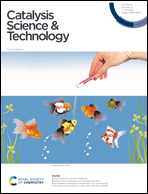Revealing the contributions of homogeneous and heterogeneous catalysis to isomerization of d-glucose into d-fructose in the presence of basic salts with low solubility†
Abstract
Isomerization of D-glucose (Glc) into D-fructose (Fru) presents an important step in the catalytic valorization of cellulosic biomass. However, a rational catalyst design for isomerization poses a challenge. In this work, we studied the catalytic activity of basic salts with low solubility Li2CO3, MgCO3, Li3PO4, SrCO3, CaCO3, BaCO3, and Mg3(PO4)2 for Glc isomerization into Fru. In bulk water, these materials generate OH−via partial dissolution and protonation of the anions. The catalysts were tested for isomerization using 10 wt% aqueous Glc solution at 60 and 80 °C. The initial rate of Fru formation r0,Fru shows an excellent correlation with the initial pH values of the reaction mixtures, indicating in situ generated OH− anions as catalytically active species. Filtration and contact tests were performed and their limited applicability for catalysis by bases with low solubility was shown. Li2CO3 showed the highest catalytic activity for the isomerization, resulting in 25% Fru yield in 10 minutes at 80 °C. The selectivity of the isomerization depends on the catalyst nature. The highest selectivity for Fru formation was observed in the presence of MgCO3, giving rise to 27% Fru yield at 80 °C. MgCO3 and MgO could be recycled without loss of activity.



 Please wait while we load your content...
Please wait while we load your content...